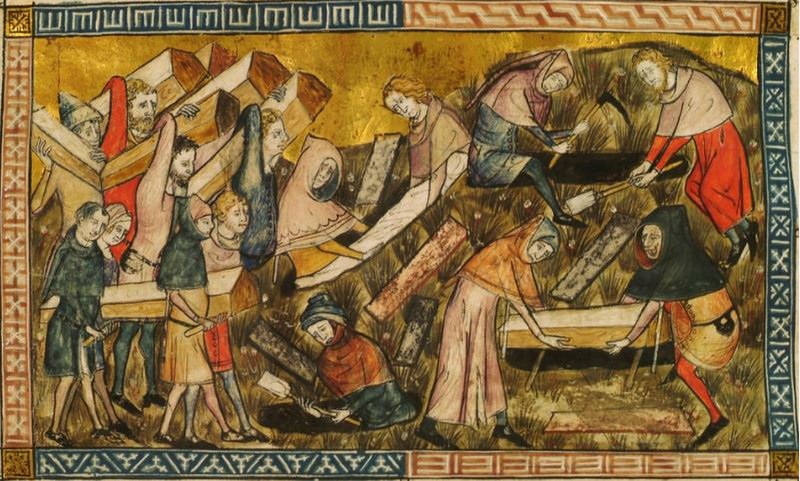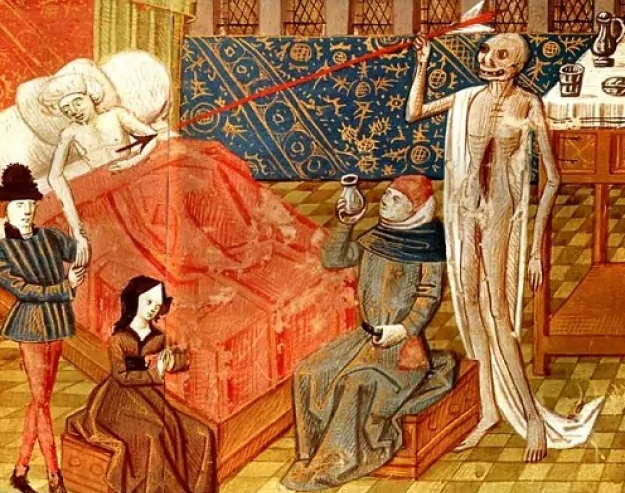The Black Death, a devastating 14th-century pandemic originating possibly in China or Central Asia, had a profound and lasting impact on Europe.
This deadly disease, primarily transmitted through fleas on black rats, led to an estimated 75 to 200 million deaths.
It reshaped European society by causing a severe labor shortage, weakening the feudal system, and influencing art and literature with themes of death and mortality.
Moreover, it sparked interest in infectious disease research, contributing to advancements in medicine. Recurrences of the plague served as reminders of the ongoing threat of infectious diseases.
The Black Death remains a somber reminder of the importance of scientific understanding in the face of catastrophic events.
Black Death Facts
1. Originated in China or Central Asia
The Black Death, one of the deadliest pandemics in history, is believed to have originated in the early 1330s in the region of China or Central Asia.
Also Read: Magna Carta Timeline
It’s thought to have initially appeared in the province of Hubei, China. From this point of origin, the disease began its relentless journey, setting in motion a series of events that would profoundly affect the world.

2. Reached Europe in 1347
The relentless march of the Black Death reached Europe in 1347. This devastating disease made its European debut in the bustling port city of Messina, Sicily, when a Genoese trading ship, carrying both cargo and the invisible threat of the bubonic plague, arrived on its shores.
Also Read: Timeline of the Black Death
From Sicily, the disease swiftly spread throughout the Italian Peninsula and, in a matter of years, had reached nearly every corner of Europe.
3. Caused by the bacterium Yersinia pestis
The cause of the Black Death is a bacterium known as Yersinia pestis. This highly contagious pathogen, transmitted primarily through fleas that infested black rats, proved to be a formidable adversary.
In addition to the bubonic form, which caused swollen lymph nodes, Yersinia pestis could also manifest as septicemic or pneumonic plague, with varying symptoms and transmission routes, making it an especially challenging disease to combat.
4. Primarily transmitted through fleas on black rats
One of the distinctive features of the Black Death was its method of transmission. Yersinia pestis, the bacterium responsible for the plague, primarily resided in fleas that infested black rats. This intricate chain of transmission began with fleas infecting rats through bites.
Once infected, these rats became carriers of the disease. When fleas bit these infected rats, they ingested the bacterium. Subsequently, when these infected fleas bit humans, they transmitted Yersinia pestis to their human hosts, initiating the disease in people.
This intricate interplay between fleas and rats played a pivotal role in the rapid spread of the Black Death throughout Europe and beyond.
5. Symptoms included buboes, fever, chills, weakness, and skin sores
The Black Death manifested in several forms, each with its own set of symptoms. The most common form was the bubonic plague, characterized by painful and swollen lymph nodes known as “buboes.”
High fever, chills, weakness, and the development of dark, oozing skin sores were also typical symptoms. In addition to the bubonic form, the plague could take on septicemic and pneumonic forms.
Septicemic plague involved the bacteria entering the bloodstream, leading to widespread infection, while pneumonic plague affected the respiratory system, causing severe pneumonia-like symptoms.
These variations in symptomatology made the Black Death even more terrifying and challenging to diagnose and combat.

6. Led to an estimated 75 to 200 million deaths in the 14th century
The Black Death left a trail of death and destruction in its wake. It is estimated to have caused the untimely deaths of an astonishing 75 to 200 million people across Europe, Asia, and Africa during the 14th century.
This staggering mortality rate meant that in some regions, entire communities were decimated, leaving behind scenes of desolation and despair.
The disease’s rapid spread, high contagion rate, and lack of effective treatments at the time contributed to its devastating impact, making it one of the deadliest pandemics in human history.
7. Rapid spread due to a lack of understanding of transmission
The rapid spread of the Black Death was facilitated by a profound lack of understanding of how the disease was transmitted.
During the 14th century, the mechanisms of infectious diseases were poorly understood, and medical knowledge was limited.
- Limited Medical Knowledge: Medical understanding during the Middle Ages was rooted in the theories of the time, such as the miasma theory, which held that diseases were caused by “bad air” or noxious odors. This misconception led people to believe that diseases were spread through foul smells rather than through microbes or specific vectors.
- Quarantine Ineffectiveness: In an attempt to contain the spread of the plague, authorities often enforced quarantines or isolation measures. However, these efforts were largely ineffective because they did not target the actual mode of transmission. People would be isolated in houses with infected family members, which only served to increase the chances of further transmission.
- Misattribution of Causes: The lack of understanding also led to various superstitious and misguided beliefs about the causes of the plague. Some communities resorted to blaming and persecuting minority groups, such as Jews, as scapegoats for the disease’s spread, leading to horrific acts of violence and discrimination.
- Travel and Trade: The Black Death spread rapidly due to the interconnectedness of medieval Europe. Trade routes and travel between regions allowed for the swift movement of infected individuals, rats, and fleas, effectively carrying the plague across vast distances in a short period.
- Limited Preventive Measures: The lack of knowledge about how to prevent or treat the disease further exacerbated its spread. People resorted to various ineffective remedies, such as wearing masks filled with aromatic herbs or carrying flowers to ward off the perceived “bad air.”
- Highly Contagious Nature: Yersinia pestis, the bacterium responsible for the plague, is highly contagious, and the fleas that transmitted it were prolific. Combined with the lack of understanding of transmission, this made containment extremely challenging.
The rapid spread of the Black Death was a result of the prevailing misconceptions about disease transmission and the inability to implement effective public health measures.
It underscores the importance of accurate scientific knowledge in combating infectious diseases and the need for evidence-based approaches to disease control and prevention.
8. Profound social and economic impact, including labor shortages
The Black Death had profound and far-reaching social and economic consequences. One of the immediate effects was a severe labor shortage.
With a significant portion of the population succumbing to the plague, there were not enough workers to sustain the agricultural and economic activities of the time. This scarcity of laborers led to higher wages for those who survived, as they could demand better terms for their work.
Landowners and nobility found it increasingly challenging to maintain the feudal system, as peasants and serfs gained more bargaining power and mobility. Consequently, this shift in the balance of power contributed to the gradual decline of feudalism in Europe.
9. Influenced art and literature, such as the “Dance of Death”
The trauma and horror of the Black Death left an indelible mark on art and literature of the time. Artists began incorporating themes related to death and mortality into their works.
The “Dance of Death” or “Danse Macabre” motif, for example, depicted skeletons or the personification of death leading people from all walks of life in a macabre dance, emphasizing the universality of mortality.
Similarly, the “Memento Mori” theme reminded individuals of their mortality and the fleeting nature of life. In literature, the impact of the plague can be seen in works like Boccaccio’s “Decameron” and Chaucer’s “The Canterbury Tales,” where stories and characters reflect the societal upheaval and existential fears of the time.
10. Recurred in Europe periodically for centuries
The Black Death did not vanish after the initial outbreak in the 14th century. Instead, it recurred in Europe periodically for centuries. Notable outbreaks occurred in the 17th century, with the Great Plague of London in 1665 being one of the most well-known.
In the 18th century, the city of Marseille in France experienced a devastating outbreak of the plague. These subsequent outbreaks, though not as widespread and catastrophic as the 14th-century pandemic, served as stark reminders of the ongoing threat of infectious diseases.
